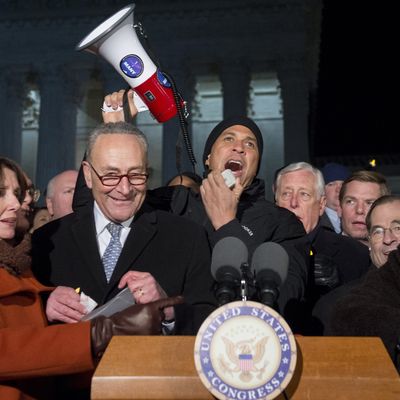
One of the big arguments about the catastrophe that engulfed Democrats last November 8 involves the alleged insufficiency of Hillary Clinton’s “positive message” for what she would do as president. This is a particularly frequent criticism levied by former supporters of Senator Bernie Sanders, who thought a “populist” economic message might have trumped Trump in ways that negative attacks on his character and issue positions could not achieve. In many cases this was, of course, part of a larger argument that a candidate like Clinton was disabled owing to her Wall Street ties and allegedly unprincipled “centrism,” but the sour grapes involved do not invalidate the claim that going medieval on Trump was not enough.
This may be an argument worth continuing in the run-up to the next presidential election, when another Democrat will likely face Trump. But the case for a positive agenda for Democrats in 2020 should not be confused with the very different question of what might work in the midterm elections of 2018. And the best answer for 2018 is that Democrats should accentuate the negative all day long.
As Michelle Cottle argues persuasively at the Atlantic, midterms are fundamentally different from presidential elections in that they are almost always a referendum on the party controlling the White House, not comparative contests with positive and negative messages from each party competing on an equal plane. She quotes political scientist Larry Sabato on the recent history of midterms:
Sabato ran through a litany of midterm outcomes from the past six decades, including Democratic wins in 1958 (“Ike’s poor economy”), 1974 (“anti-Watergate, anti-Nixon pardon”), and 1982 (“Reagan’s poor economy”), and Republican wins in 1966 (“anti-Vietnam War, Great Society backlash”), 1994 (“Clinton’s poor economy and controversies”), and 2010 (“anti-Obamacare, continuing poor economy”). “In every case, for each party,” said Sabato, “victory wasn’t delivered on account of a terrific positive platform but because of a negative reaction to the policies and actions of the incumbent president and/or Congress.”
Some might argue that 1994, when Republicans conquered Congress after campaigning on a vague but comprehensive-sounding ten-point “Contract With America,” shows the potential power of a positive midterm message. That’s the legend, but in truth Pew found on the eve of that election that only one in three voters had ever heard of the “contract,” and it had virtually no net effect on voting preferences.
It is true that midterm negativity can be taken to counterproductive lengths, as occurred in 1998 when the GOP effort to impeach Bill Clinton backfired pretty badly. Four years later, Democrats struggled even more in a midterm, partly because they alternated between attacking and agreeing with George W. Bush in that security-haunted era, and partly because 9/11 gave Bush a level of extraordinary popularity that had only partially worn off by 2002 (his approval rating on Election Day was 63 percent).
By and large, though, the presidential party loses ground in midterms, and the opposition party can enhance the natural backlash by piling on, not by offering alternative courses of action that most voters will simply ignore.
Cottle emphasizes the example set by Democrats last time they were in this position, after George W. Bush was reelected along with GOP majorities in Congress. They began by going crazy negative on W.’s proposal to partially privatize Social Security, and then W.’s own mistakes began to snowball:
Broadly, 2006 was a referendum on Bush 43’s job approval, which had taken a major hit thanks to his shabby handling of Hurricane Katrina and, more importantly, his Iraq war folly. Democrats beat those drums hard. They also spotlighted a string of nasty scandals plaguing congressional Republicans during that period. (Anyone recall Mark Foley’s penchant for teenage House pages?)
And so Democrats carried the day, despite having put forth nothing remotely approaching a grand governing message, or even a cohesive brand identity.
The durable bitterness of the Clinton-Sanders contest of 2016 should not obscure the fact that Democrats maintained a significantly broader ideological tent in 2006 than they do today, if only because the party’s Southern wing had not entirely atrophied. Democrats would have been hard-pressed to come up with a unifying, positive agenda. So they didn’t even try, and prospered anyway.
Donald Trump dominates the political landscape today in ways that George W. Bush — or indeed, any president since Ronald Reagan, or arguably Lyndon Johnson — could not have dreamed of equaling. His popularity ratio, however, is far worse than any recent president at this early stage of his presidency. It is an environment tailor-made for a bad White House midterm and for an opposition focused intently on making it worse. For a donkey party searching to regain its kick, the positive stuff can come later.






























